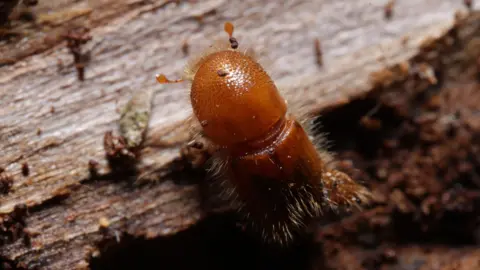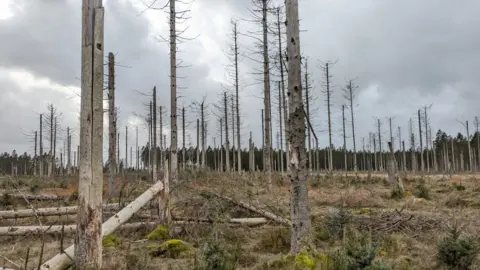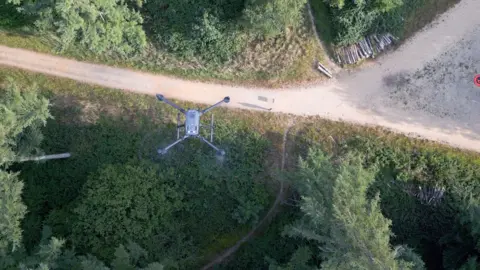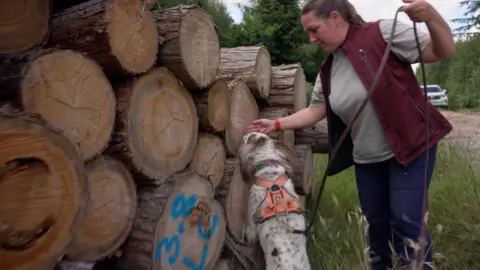AI Research
New AI Tool Unveils 1,000 Potentially Unreliable Scientific Journals

A team of researchers from the University of Colorado Boulder has made significant strides in combating a growing problem in the academic world: predatory journals. These journals have emerged as a troubling trend where researchers are targeted and often manipulated into paying substantial fees for dubious publication practices. In a groundbreaking study published on August 27 in the journal Science Advances, this team has introduced an innovative artificial intelligence (AI) platform designed to identify these questionable scientific publications automatically.
Daniel Acuña, the lead author of this crucial study, is an associate professor in the Department of Computer Science at the University of Colorado. His personal experiences have illustrated the pressing need for such a tool. Acuña receives frequent emails from so-called editors promising to publish his research for a hefty price, which often leads to the alarming realization that many of these journals are essentially scams. He coined the term “predatory journals” to describe how these entities prey on scientists, luring them with promises of instant publication without the rigors of genuine peer review.
The evolution of the predatory journal phenomenon can be traced back to 2009 when Jeffrey Beall, a librarian at CU Denver, first articulated the concept. This growing trend is particularly concerning given the pressures placed on researchers worldwide, especially in countries with emerging scientific institutions like China, India, and Iran. Here, researchers are often required to publish frequently, leading them to vulnerable positions where predatory journals exploit their need to contribute to scholarly literature without the necessary safeguards in place.
In recognizing the scale of the issue, Acuña’s team developed an AI-driven system that scrutinizes an extensive array of journals. The tool evaluates various factors that might indicate a publication’s legitimacy, such as the presence of an editorial board consisting of established researchers and the frequency of grammatical errors on the journal’s website. The need for such a solution is underscored by the ease with which predatory journals can appear and disappear. Once flagged, these journals can simply change their names and web addresses in a never-ending cycle that researchers find difficult to track.
Despite the multifaceted challenges posed by predatory journals, Acuña asserts that the AI tool is not a perfect solution and is intended to supplement, not replace, human expertise. The nuanced judgment required to assess a journal’s credibility is still best suited to seasoned academics who can better evaluate the context and quality of the scientific outputs on offer. Acuña’s belief in human oversight is essential in ensuring that legitimate journals are not mistakenly categorized as predatory.
Moreover, as scientific legitimacy comes under scrutiny, the implications of unchecked publication practices are dire. The foundation of scientific progress relies on the accuracy and reliability of prior research; without stringent controls, the very structure upon which further scientific inquiry is built could easily crumble, leading to a significant erosion of trust in research as a whole. This urgency drives scientists and institutions to act decisively against the proliferation of fraudulent journals.
The study’s findings indicated that among the nearly 15,200 open-access journals analyzed, the AI initially flagged more than 1,400 as potentially dubious. Subsequent human reviews returned an estimated error rate, revealing approximately 350 journals erroneously labeled as problematic. Nevertheless, this resulted in over 1,000 journals that warranted further investigation, affirming the AI’s utility as a prescreening tool to help researchers sift through the vast landscape of online publications more efficiently.
Acuña’s team did not wish to create an opaque “black box” model like many other AI tools; they aimed for transparency in their design. Users can understand the rationale behind the tool’s assessments, an aspect that adds to the overall reliability of the system. Their research revealed that questionable journals frequently publish a high volume of articles and possess authors with numerous affiliations, alongside a tendency for authors to excessively cite their own work rather than integrating broader scientific discourse.
Although the AI system is not yet publicly available, there are plans for it to be deployed in universities and by publishing companies. Acuña envisions this tool as an essential resource in maintaining the integrity of scientific research, effectively acting as a “firewall for science.” Such a mechanism could ensure that the data informing future discoveries is solid and dependable, helping to fortify the scientific community against the detrimental effects of bad data.
To put the significance of the findings into perspective, Acuña makes a relatable analogy to the way we approach technology. Just as consumers come to expect updates and bug fixes with new smartphones, the field of science must similarly adapt, recognizing the need for continual refinements in its publishing practices. Through innovations like Acuña’s AI platform, the academic community can strive to reclaim the integrity that is crucial to scholarly advancement.
With the potential to reach an audience eager for solutions to a pervasive problem, the research encapsulates the challenges posed by predatory journals and the efforts being made to combat them using advanced technology. These developments signal a hopeful turn in the ongoing battle for credibility in academic publishing. As universities and research institutions grapple with this complex issue, the AI platform represents a step toward reclaiming control and ensuring that the foundations of science remain sound.
The urgency of safeguarding against disreputable publications has never been greater. As science increasingly relies on vast networks of information, the potential for misleading or fraudulent research to undermine years of progress looms large. The challenges posed by predatory journals must be addressed methodically and rigorously, as the validity of scientific research—essential for societal advancement—hangs in the balance. Protecting the sanctity of academic publishing is not merely an academic endeavor but a vital necessity for preserving trust in the scientific enterprise.
In conclusion, Acuña and his team’s efforts not only highlight the critical need for vigilance in the face of predatory practices but also showcase how cutting-edge technology can be harnessed effectively to combat these challenges. Their work represents a clear call to both the scientific community and the public to remain aware of the complexities of academic publishing and encourages further discourse on the mechanisms that can safeguard the future of research integrity.
Subject of Research: Identification of questionable scientific journals using artificial intelligence.
Article Title: Estimating the predictability of questionable open-access journals.
News Publication Date: August 27, 2023.
Web References: Science Advances
References: Directory of Open Access Journals
Image Credits: University of Colorado Boulder.
Keywords
AI, predatory journals, scientific publishing, research integrity, academic reputation, peer review.
Tags: AI tools for identifying predatory journalsautomated detection of unreliable scientific journalschallenges in academic publishing integritycombating academic publication scamsDaniel Acuña predatory journals studyethical concerns in academic publishinghistory of predatory journalsimpact of predatory journals on researchersinnovations in combating academic fraudScience Advances publication on AI toolsignificance of peer review in publishingUniversity of Colorado Boulder research
AI Research
Tories pledge to get ‘all our oil and gas out of the North Sea’

Conservative leader Kemi Badenoch has said her party will remove all net zero requirements on oil and gas companies drilling in the North Sea if elected.
Badenoch is to formally announce the plan to focus solely on “maximising extraction” and to get “all our oil and gas out of the North Sea” in a speech in Aberdeen on Tuesday.
Reform UK has said it wants more fossil fuels extracted from the North Sea.
The Labour government has committed to banning new exploration licences. A spokesperson said a “fair and orderly transition” away from oil and gas would “drive growth”.
Exploring new fields would “not take a penny off bills” or improve energy security and would “only accelerate the worsening climate crisis”, the government spokesperson warned.
Badenoch signalled a significant change in Conservative climate policy when she announced earlier this year that reaching net zero would be “impossible” by 2050.
Successive UK governments have pledged to reach the target by 2050 and it was written into law by Theresa May in 2019. It means the UK must cut carbon emissions until it removes as much as it produces, in line with the 2015 Paris Climate Agreement.
Now Badenoch has said that requirements to work towards net zero are a burden on oil and gas producers in the North Sea which are damaging the economy and which she would remove.
The Tory leader said a Conservative government would scrap the need to reduce emissions or to work on technologies such as carbon storage.
Badenoch said it was “absurd” the UK was leaving “vital resources untapped” while “neighbours like Norway extracted them from the same sea bed”.
In 2023, then Prime Minister Rishi Sunak granted 100 new licences to drill in the North Sea which he said at the time was “entirely consistent” with net zero commitments.
Reform UK has said it will abolish the push for net zero if elected.
The current government said it had made the “biggest ever investment in offshore wind and three first of a kind carbon capture and storage clusters”.
Carbon capture and storage facilities aim to prevent carbon dioxide (CO2) produced from industrial processes and power stations from being released into the atmosphere.
Most of the CO2 produced is captured, transported and then stored deep underground.
It is seen by the likes of the International Energy Agency and the Climate Change Committee as a key element in meeting targets to cut the greenhouse gases driving dangerous climate change.
AI Research
Dogs and drones join forest battle against eight-toothed beetle

Esme Stallard and Justin RowlattClimate and science team
 Sean Gallup/Getty Images
Sean Gallup/Getty ImagesIt is smaller than your fingernail, but this hairy beetle is one of the biggest single threats to the UK’s forests.
The bark beetle has been the scourge of Europe, killing millions of spruce trees, yet the government thought it could halt its spread to the UK by checking imported wood products at ports.
But this was not their entry route of choice – they were being carried on winds straight over the English Channel.
Now, UK government scientists have been fighting back, with an unusual arsenal including sniffer dogs, drones and nuclear waste models.
They claim the UK has eradicated the beetle from at risk areas in the east and south east. But climate change could make the job even harder in the future.
The spruce bark beetle, or Ips typographus, has been munching its way through the conifer trees of Europe for decades, leaving behind a trail of destruction.
The beetles rear and feed their young under the bark of spruce trees in complex webs of interweaving tunnels called galleries.
When trees are infested with a few thousand beetles they can cope, using resin to flush the beetles out.
But for a stressed tree its natural defences are reduced and the beetles start to multiply.
“Their populations can build to a point where they can overcome the tree defences – there are millions, billions of beetles,” explained Dr Max Blake, head of tree health at the UK government-funded Forestry Research.
“There are so many the tree cannot deal with them, particularly when it is dry, they don’t have the resin pressure to flush the galleries.”
Since the beetle took hold in Norway over a decade ago it has been able to wipe out 100 million cubic metres of spruce, according to Rothamsted Research.
‘Public enemy number one’
As Sitka spruce is the main tree used for timber in the UK, Dr Blake and his colleagues watched developments on continental Europe with some serious concern.
“We have 725,000 hectares of spruce alone, if this beetle was allowed to get hold of that, the destructive potential means a vast amount of that is at risk,” said Andrea Deol at Forestry Research. “We valued it – and it’s a partial valuation at £2.9bn per year in Great Britain.”
There are more than 1,400 pests and diseases on the government’s plant health risk register, but Ips has been labelled “public enemy number one”.
The number of those diseases has been accelerating, according to Nick Phillips at charity The Woodland Trust.
“Predominantly, the reason for that is global trade, we’re importing wood products, trees for planting, which does sometimes bring ‘hitchhikers’ in terms of pests and disease,” he said.
Forestry Research had been working with border control for years to check such products for Ips, but in 2018 made a shocking discovery in a wood in Kent.
“We found a breeding population that had been there for a few years,” explained Ms Deol.
“Later we started to pick up larger volumes of beetles in [our] traps which seemed to suggest they were arriving by other means. All of the research we have done now has indicated they are being blown over from the continent on the wind,” she added.
 Daegan Inward/Forestry Research
Daegan Inward/Forestry ResearchThe team knew they had to act quickly and has been deploying a mixture of techniques that wouldn’t look out of place in a military operation.
Drones are sent up to survey hundreds of hectares of forest, looking for signs of infestation from the sky – as the beetle takes hold, the upper canopy of the tree cannot be fed nutrients and water, and begins to die off.
But next is the painstaking work of entomologists going on foot to inspect the trees themselves.
“They are looking for a needle in a haystack, sometimes looking for single beetles – to get hold of the pioneer species before they are allowed to establish,” Andrea Deol said.
In a single year her team have inspected 4,500 hectares of spruce on the public estate – just shy of 7,000 football pitches.
Such physically-demanding work is difficult to sustain and the team has been looking for some assistance from the natural and tech world alike.
 Tony Jolliffe/BBC
Tony Jolliffe/BBCWhen the pioneer Spruce bark beetles find a suitable host tree they release pheromones – chemical signals to attract fellow beetles and establish a colony.
But it is this strong smell, as well as the smell associated with their insect poo – frass – that makes them ideal to be found by sniffer dogs.
Early trials so far have been successful. The dogs are particularly useful for inspecting large timber stacks which can be difficult to inspect visually.
The team is also deploying cameras on their bug traps, which are now able to scan daily for the beetles and identify them in real time.
“We have [created] our own algorithm to identify the insects. We have taken about 20,000 images of Ips, other beetles and debris, which have been formally identified by entomologists, and fed it into the model,” said Dr Blake.
Some of the traps can be in difficult to access areas and previously had only been checked every week by entomologists working on the ground.
The result of this work means that the UK has been confirmed as the first country to have eradicated Ips Typographus in its controlled areas, deemed to be at risk from infestation, and which covers the south east and east England.
“What we are doing is having a positive impact and it is vital that we continue to maintain that effort, if we let our guard down we know we have got those incursion risks year on year,” said Ms Deol.
 Tony Jolliffe/BBC
Tony Jolliffe/BBCAnd those risks are rising. Europe has seen populations of Ips increase as they take advantage of trees stressed by the changing climate.
Europe is experiencing more extreme rainfall in winter and milder temperatures meaning there is less freezing, leaving the trees in waterlogged conditions.
This coupled with drier summers leaves them stressed and susceptible to falling in stormy weather, and this is when Ips can take hold.
With larger populations in Europe the risk of Ips colonies being carried to the UK goes up.
The team at Forestry Research has been working hard to accurately predict when these incursions may occur.
“We have been doing modelling with colleagues at the University of Cambridge and the Met Office which have adapted a nuclear atmospheric dispersion model to Ips,” explained Dr Blake. “So, [the model] was originally used to look at nuclear fallout and where the winds take it, instead we are using the model to look at how far Ips goes.”
Nick Phillips at The Woodland Trust is strongly supportive of the government’s work but worries about the loss of ancient woodland – the oldest and most biologically-rich areas of forest.
Commercial spruce have long been planted next to such woods, and every time a tree hosting spruce beetle is found, it and neighbouring, sometimes ancient trees, have to be removed.
“We really want the government to maintain as much of the trees as they can, particularly the ones that aren’t affected, and then also when the trees are removed, supporting landowners to take steps to restore what’s there,” he said. “So that they’re given grants, for example, to be able to recover the woodland sites.”
The government has increased funding for woodlands in recent years but this has been focused on planting new trees.
“If we only have funding and support for the first few years of a tree’s life, but not for those woodlands that are 100 or century years old, then we’re not going to be able to deliver nature recovery and capture carbon,” he said.
Additional reporting Miho Tanaka

AI Research
AI replaces excuses for innovation, not jobs
AI isn’t here to replace jobs, it’s here to eliminate outdated practices and empower entrepreneurs to innovate faster and smarter than ever before.

-
Tools & Platforms3 weeks ago
Building Trust in Military AI Starts with Opening the Black Box – War on the Rocks
-

 Ethics & Policy1 month ago
Ethics & Policy1 month agoSDAIA Supports Saudi Arabia’s Leadership in Shaping Global AI Ethics, Policy, and Research – وكالة الأنباء السعودية
-

 Events & Conferences3 months ago
Events & Conferences3 months agoJourney to 1000 models: Scaling Instagram’s recommendation system
-

 Jobs & Careers2 months ago
Jobs & Careers2 months agoMumbai-based Perplexity Alternative Has 60k+ Users Without Funding
-

 Business1 day ago
Business1 day agoThe Guardian view on Trump and the Fed: independence is no substitute for accountability | Editorial
-

 Funding & Business2 months ago
Funding & Business2 months agoKayak and Expedia race to build AI travel agents that turn social posts into itineraries
-

 Education2 months ago
Education2 months agoVEX Robotics launches AI-powered classroom robotics system
-

 Podcasts & Talks2 months ago
Podcasts & Talks2 months agoHappy 4th of July! 🎆 Made with Veo 3 in Gemini
-

 Podcasts & Talks2 months ago
Podcasts & Talks2 months agoOpenAI 🤝 @teamganassi
-

 Jobs & Careers2 months ago
Jobs & Careers2 months agoAstrophel Aerospace Raises ₹6.84 Crore to Build Reusable Launch Vehicle


